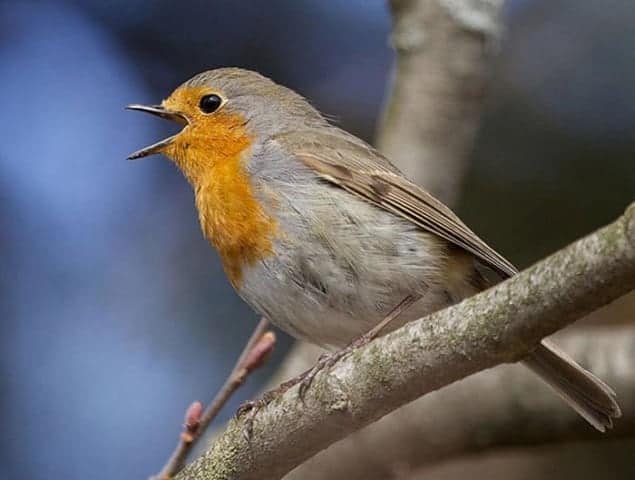
According to the “radical pair” model, some migratory birds exploit the quantum phenomenon of electron spin to navigate using the Earth’s magnetic field. This idea has now been bolstered by a new study from physicists in Singapore, who have shown that the spin-based process and the dynamics of a proposed “compass” molecule take place over similar timescales. The team also shows that the sensitivity of the avian compass can be enhanced, rather than degraded, by environmental noise. Others in the field, however, take issue with the latest results.
Many birds are believed to navigate long distances using the Earth’s magnetic field. Some species, such as the European robin, are thought not to exploit the geomagnetic-field’s polarity but instead its orientation relative to the horizontal, from which the directions north and south can be derived. It is believed that these birds’ magnetic sense organ is embedded in their eyes.
The radical-pair hypothesis says that incoming photons excite molecules in the birds’ retinas, causing an electron to transfer between two adjacent molecules and leave each of those molecules with an unpaired electron spin. The tendency for those spins to point in either the same or opposite directions while the molecules remain excited – states known as triplets and singlets, respectively – depends on the orientation of those molecules to an external magnetic field.
Singlets and triplets
Molecules lying along the field lines tend to favour the singlet state. A bird can therefore determine the orientation of the geomagnetic field by comparing the effect of the field on molecules arranged at different angles across the retina. According to one popular version of the hypothesis, singlets and triplets yield different chemical messengers that travel to the bird’s brain.
Last year, Erik Gauger and colleagues at the University of Oxford and the National University of Singapore calculated how long these pairs of molecules typically remain excited, using data from behavioural studies that showed how oscillating magnetic fields can disrupt the sense of direction of European robins. Taking the value for the smallest field strength shown to disable orientation, Gauger’s group worked out the minimum “radical-pair lifetime” to be around 100 μs and, taking into account possible sources of environmental noise, found that the quantum states generated by the excited molecules should persist for around the same length of time (Phys. Rev. Lett. 106 040503). The researchers pointed out that this exceeded the longevity of quantum states achieved in the laboratory and, as they saw it, weakened the view that life is too “warm and wet” to sustain delicate quantum phenomena.
However, in the new research (Phys. Rev. Lett. 109 110502), Dagomir Kaszlikowski and colleagues at the National University of Singapore argue that this earlier work falls down because it fails to take into account another behavioural study that considered the effect of an artificial static field on European robins’ orientation. That study showed that the birds become disorientated when they experience a total field strength at least a third larger or smaller than the natural geomagnetic field. Kaszlikowski’s group argues that when this study is taken into account, the radical-pair lifetime is just 5–7 μs.
The shorter the better
The researchers say that this figure agrees well with the excitation time of cryptochrome, the pigment molecule that is believed to generate the radical pairs within the retinas of European robins, according to independent experimental data. Kaszlikowski and colleagues also show theoretically that the robin’s compass can, under certain circumstances, be made more sensitive to changes in the relative orientation of the Earth’s magnetic field when there is environmental noise compared with when there is none. As a result, they conclude, longer-lasting quantum states may sometimes impede navigation.
Responding to the latest research, Gauger and his colleague Simon Benjamin of the University of Oxford say that the new figure for the radical-pair lifetime is not reliable, arguing that Kaszlikowski and his co-workers have carried out their analysis using a “pick and mix” of data points. Had the rival group selected its data differently, Gauger and Benjamin maintain, its figure “would have not have been very different from ours”.
Important unanswered question
Benjamin says that in any case the result does not alter what he considers to be an important unanswered question: why do the robins take so long to get their magnetic reading? He argues that the field orientation could be established in just tens or hundreds of nanoseconds, rather than in microseconds, and that it is not in the birds’ interest to take any longer, since a quicker process means more information, and therefore a better signal, in any given time interval.
The answer, he believes, might lie in a mechanism based on physics rather than chemistry. Describing a model that he and others developed with the recently deceased Marshall Stoneham, he explains that each pair of molecules excited by an incoming photon acts as a tiny electrical dipole, so the many molecules in the eye collectively generate an electric field. Such fields can directly affect normal vision, leading to darker or lighter patches. Triplet states generate more fields since they last longer. “A longer excitation time would lead to a stronger visual effect, improving the compass rather than making it worse,” he says. “This seems to provide a clearer evolutionary path.”



